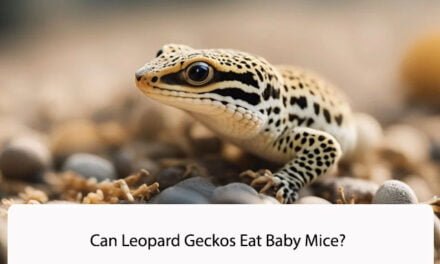Leopard geckos are fascinating creatures that make great pets for reptile enthusiasts. As with any pet, it is important to understand their dietary needs to ensure they stay healthy and happy. One common question that many leopard gecko owners have is whether or not their gecko can eat pinkies.
Pinkies are newborn mice that have not yet developed fur. They are often sold as food for reptiles and other carnivorous pets. While some leopard gecko owners choose to feed their geckos pinkies, there are some important factors to consider before doing so. In this article, we will explore the topic of whether or not leopard geckos can eat pinkies and provide you with the information you need to make an informed decision about your gecko’s diet.
Dietary Basics of Leopard Geckos

As pet owners, it is crucial to understand the dietary requirements of our leopard geckos to ensure their good health and longevity. In this section, we will discuss the nutritional requirements of leopard geckos and their natural diet in the wild.
Nutritional Requirements
Leopard geckos are insectivores, which means they primarily feed on insects. In captivity, a balanced diet for leopard geckos should consist of a variety of insects such as crickets, mealworms, waxworms, and superworms. These insects should be gut-loaded, which means they are fed a nutritious diet before being fed to the leopard gecko. Additionally, supplements such as calcium and vitamin D3 should be added to their diet to prevent nutritional deficiencies.
It is important to note that leopard geckos do not require fruits, vegetables, or pinkies (baby mice) in their diet. In fact, feeding them such items can lead to health problems such as obesity and digestive issues.
Natural Diet in the Wild
In the wild, leopard geckos primarily feed on insects such as crickets, beetles, and grasshoppers. They are also known to eat small lizards and spiders. Their diet varies depending on their habitat and the availability of prey.
Leopard geckos have a unique feeding behavior where they stalk and pounce on their prey. They are nocturnal hunters and rely on their keen sense of smell and sight to locate their prey.
In conclusion, understanding the dietary requirements of leopard geckos is crucial for their health and well-being. Providing them with a balanced diet of gut-loaded insects and supplements will ensure they receive the necessary nutrients they need to thrive.
Understanding Pinkies

What Are Pinkies?
Pinkies are a common food item for many reptiles, including leopard geckos. They are basically newborn mice that have not yet grown fur and have pink skin. Pinkies are usually fed to reptiles that are small in size and cannot handle larger prey.
Pinkies are available in different sizes, ranging from small to extra-large. It is important to choose the right size of pinkie for your leopard gecko, depending on its size and age. Feeding your leopard gecko a pinkie that is too large can cause digestive problems, while a pinkie that is too small may not provide enough nutrition.
Nutritional Value of Pinkies
Pinkies are a good source of nutrition for leopard geckos. They are rich in protein, fat, and other essential nutrients that are necessary for the growth and development of your pet. However, it is important to note that pinkies are not a complete diet and should be fed in conjunction with other food items.
Here is a breakdown of the nutritional value of pinkies per 100 grams:
| Nutrient | Amount |
|---|---|
| Protein | 11.6 g |
| Fat | 4.5 g |
| Calcium | 11 mg |
| Phosphorus | 123 mg |
| Iron | 1.2 mg |
As you can see, pinkies are high in protein and fat, which are important for the growth and development of your leopard gecko. However, they are low in calcium, which is essential for bone health. Therefore, it is important to supplement your leopard gecko’s diet with calcium powder or other calcium-rich food items.
Feeding Pinkies to Leopard Geckos

Leopard geckos are carnivorous and require a diet that is high in protein. Pinkies, which are newborn mice, are a popular food choice for leopard geckos. However, it is important to understand the appropriate age for consumption, frequency of feeding pinkies, and potential health risks associated with this feeding option.
Appropriate Age for Consumption
Leopard geckos can consume pinkies as early as two weeks old. However, it is important to note that younger geckos may struggle to digest the bones and fur of the pinkies. Therefore, it is recommended to wait until the gecko is at least four to six weeks old before introducing pinkies into their diet.
Frequency of Feeding Pinkies
Pinkies should not be the sole source of food for leopard geckos. It is recommended to feed pinkies to leopard geckos once a week as a supplement to their regular diet. Overfeeding pinkies can lead to obesity and other health issues.
Potential Health Risks
Feeding pinkies to leopard geckos can pose certain health risks if not done properly. Firstly, it is important to ensure that the pinkies are fresh and have not been frozen for an extended period of time. Frozen pinkies can contain harmful bacteria that can cause illness in leopard geckos. Additionally, geckos may choke on the bones or fur of the pinkies if they are not properly chewed and digested.
In conclusion, feeding pinkies to leopard geckos can be a beneficial supplement to their diet as long as it is done properly and in moderation. It is important to understand the appropriate age for consumption, frequency of feeding pinkies, and potential health risks associated with this feeding option.
Safe Feeding Practices
When it comes to feeding leopard geckos, it’s important to follow safe feeding practices to ensure the health and well-being of your pet. Here are a few tips to keep in mind:
Preparing Pinkies for Feeding
Pinkies, or baby mice, are a common food source for leopard geckos. However, it’s important to ensure that the pinkies are prepared properly before feeding them to your gecko. Here are a few steps to follow:
- Thaw the pinkies in the refrigerator overnight.
- Warm the pinkies to room temperature before feeding.
- Remove any excess fur or skin from the pinkies.
- Use feeding tongs to offer the pinkies to your gecko.
By following these steps, you can ensure that the pinkies are safe and healthy for your gecko to eat.
Monitoring Your Gecko’s Health
It’s important to monitor your gecko’s health regularly, especially after feeding. Here are a few signs to watch for:
- Changes in appetite or eating habits
- Weight loss or gain
- Changes in behavior or activity level
- Abnormalities in stool or feces
If you notice any of these signs, it’s important to consult with a veterinarian who specializes in reptiles. Regular check-ups and monitoring can help ensure that your gecko stays healthy and happy.
By following safe feeding practices and monitoring your gecko’s health, you can help ensure that your pet stays healthy and happy for years to come.
Alternatives to Pinkies

If you’re looking for alternatives to feeding your leopard gecko pinkies, there are a few options to consider. Here are some of the most popular alternatives:
Commercial Diets
One option is to feed your leopard gecko a commercial diet. There are many different brands and types of commercial diets available, so it’s important to do your research and find one that is high-quality and appropriate for your gecko’s age and size.
Some of the most popular commercial diets for leopard geckos include:
- Repashy Superfoods
- Pangea Fruit Mix Complete Gecko Diet
- Zoo Med Natural Grassland Tortoise Food
- Fluker’s Buffet Blend
When feeding your leopard gecko a commercial diet, it’s important to follow the instructions carefully and make sure that your gecko is getting all of the nutrients it needs.
Live Insect Options
Another option is to feed your leopard gecko live insects. This is a more natural option and can be a great way to provide your gecko with a varied diet.
Some of the best live insects to feed your leopard gecko include:
- Crickets
- Mealworms
- Dubia Roaches
- Waxworms
When feeding live insects, it’s important to make sure that they are the appropriate size for your gecko and that they are gut-loaded with nutritious foods before feeding.
Overall, there are many alternatives to feeding your leopard gecko pinkies. By doing your research and choosing high-quality, nutritious options, you can provide your gecko with a healthy and varied diet.
Frequently Asked Questions
Is it safe for leopard geckos to consume pinky mice?
Yes, leopard geckos can consume pinky mice. Pinkies are newborn mice that have not yet grown fur, and they are a good source of nutrition for leopard geckos. However, it is important to note that pinkies should only be given as an occasional treat and not as a regular part of their diet.
What are the dietary restrictions for leopard geckos?
Leopard geckos are insectivores, which means they primarily eat insects. They should be fed a diet that consists mainly of crickets, mealworms, and waxworms. It is important to provide a variety of insects to ensure that they receive a balanced diet. Additionally, leopard geckos should not be fed insects that are too large, as this can cause digestive problems.
Can leopard geckos have fruit as part of their diet?
Leopard geckos do not typically eat fruit as part of their diet. Their digestive systems are not designed to process high amounts of sugar and fruit can cause digestive problems. It is best to stick to a diet of primarily insects and occasional treats like pinky mice.
Do leopard geckos ever eat small reptiles or snakes?
No, leopard geckos do not typically eat other reptiles or snakes. They are small and have a limited diet that consists mainly of insects. It is important to provide a variety of insects to ensure that they receive a balanced diet.
What insects are appropriate for leopard geckos to eat?
Leopard geckos can eat a variety of insects, including crickets, mealworms, waxworms, and roaches. It is important to provide a variety of insects to ensure that they receive a balanced diet. Additionally, insects should be gut-loaded before feeding to ensure that they are nutritious.
Are there any risks associated with feeding pinkies to leopard geckos?
Feeding pinkies to leopard geckos can be risky if they are not properly prepared. Pinkies should be frozen and thawed before feeding to ensure that they are free of parasites and bacteria. Additionally, pinkies should only be given as an occasional treat and not as a regular part of their diet, as they are high in fat and can cause digestive problems if consumed in excess.





